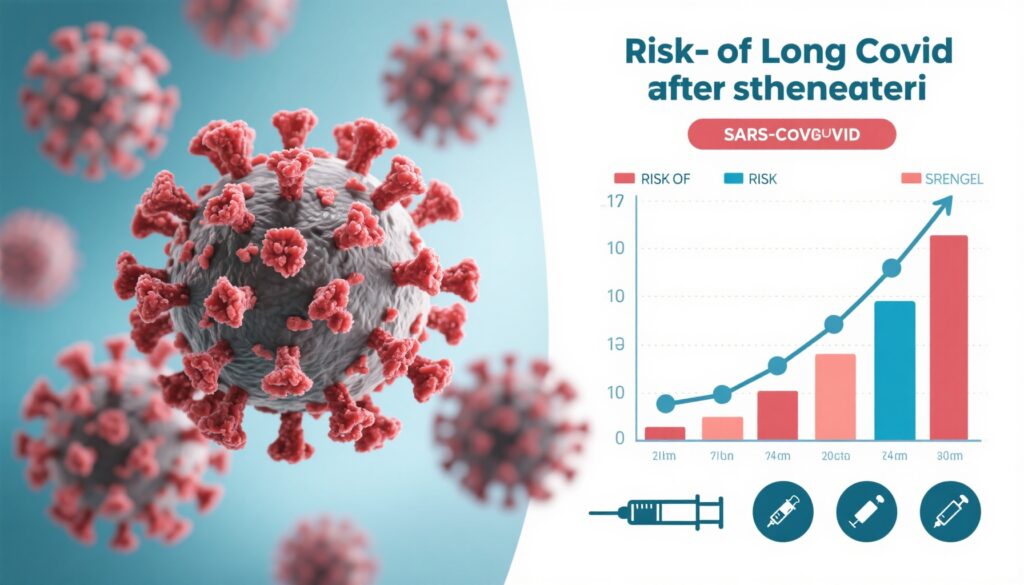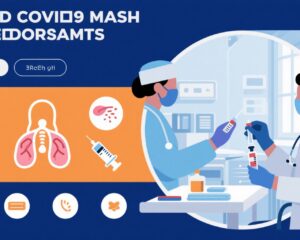Highlights
- SARS-CoV-2 reinfection is associated with a 35% increased risk of developing long COVID compared to a single infection.
- Incidence of long COVID after reinfection is higher across all age groups, notably more pronounced in older adults.
- Recent vaccination between infections is linked to reduced long COVID risk, suggesting immunologic benefit from updated vaccines.
- The complex interplay of patient age, vaccination timing, and comorbidities influences long COVID incidence post-reinfection, requiring tailored clinical approaches.
Background
Long COVID, characterized by persistent and diverse symptoms extending beyond the acute phase of SARS-CoV-2 infection, remains a significant public health concern. As the pandemic progressed with successive variants such as Omicron, reinfections became more frequent, raising questions about cumulative risk for persistent symptoms. Understanding how reinfection and vaccination timing interplay to affect long COVID risk is critical to informing clinical care and vaccination policies.
Key Content
Study Design and Cohort Characteristics
The RTI International–led observational study utilized electronic health records from the National Clinical Cohort Collaborative within the NIH-funded RECOVER Initiative, encompassing 424,616 matched US adult participants who had SARS-CoV-2 infection and reinfections documented between March 2020 and June 2024. The cohort was derived from 85 hospitals and hospital networks, providing a geographically and demographically diverse sample.
Incidence and Risk of Long COVID After Reinfection
Among reinfected individuals, 12.1% developed long COVID compared to 8.7% among controls with only one infection. Cumulative incidence over one year post-index date was 11.1% for reinfected versus 8.2% in non-reinfected controls. Statistically, reinfection increased long COVID risk by 35% (risk ratio [RR] 1.35), with an absolute risk difference (aRD) of 2.9%. This increased risk persisted regardless of sex or initial disease severity but varied by age, with older adults (≥36 years) demonstrating notably higher absolute risk differences than younger adults.
Impact of Vaccination Timing on Long COVID Risk
A subanalysis of 13 sites with detailed vaccination data classified participants into four groups based on vaccination timing relative to infections. Those vaccinated between their first and second infections showed lower long COVID risk from reinfection (RR 1.19) compared to those vaccinated only before first infection (RR 1.45) or unvaccinated (RR 1.33). These findings highlight that more recent vaccination may confer immunologic protection that mitigates post-viral sequelae following reinfection.
Age and Comorbidity Considerations
Age stratification revealed an increasing absolute risk difference by age groups, indicating that older populations are disproportionately affected by long COVID after reinfection. Vaccinated individuals tended to be older with a higher burden of comorbidities and healthcare utilization, potentially inflating observed incidence rates, necessitating careful interpretation to isolate vaccine effects from confounders.
Limitations and Need for Further Research
As a non-peer-reviewed observational study relying on electronic health record data, potential biases include misclassification, residual confounding by comorbidities and healthcare access, and variability in long COVID coding practices. Additionally, heterogeneity in vaccine types, doses, and circulating variants complicates direct attribution of effects. More granular data and prospective studies are required to clarify mechanistic pathways by which reinfection and vaccination modulate long COVID risk.
Expert Commentary
This large-scale study underscores reinfection as a significant risk factor for long COVID, reinforcing the need for continued monitoring of patients with recurrent SARS-CoV-2 infection. The protective signal associated with vaccination between infections suggests that timely booster doses may mitigate post-acute sequelae by boosting immune memory or modifying viral persistence.
Mechanistically, repeated exposure to SARS-CoV-2 might amplify maladaptive immune responses or tissue damage, cumulatively increasing symptom burden. Vaccines may help by priming more effective viral clearance and reducing systemic inflammation.
Clinicians should consider patient age, infection history, and vaccination status when assessing long COVID risk and advising on vaccination. Public health strategies need to emphasize booster uptake, especially in populations at higher risk for reinfection and chronic symptoms.
Conclusion
The RTI International cohort study contributes important evidence that SARS-CoV-2 reinfection substantially raises the likelihood of developing long COVID. Recent vaccination between infections appears to attenuate this risk, although further research is needed to delineate immunologic mechanisms and optimize vaccination schedules. Clinicians and policymakers should integrate these insights into risk stratification, patient counseling, and vaccination campaigns to reduce long-term morbidity associated with COVID-19.
References
- RTI International. Incidence of Long COVID Following Reinfection with COVID-19. medRxiv. 2025. doi:10.1101/2025.08.12.25333155
- National Institutes of Health RECOVER Initiative. Long COVID Research Framework. Available from: https://recovercovid.org
- Centers for Disease Control and Prevention. Post-COVID Conditions. Updated 2023. Available from: https://cdc.gov/coronavirus/longcovid



